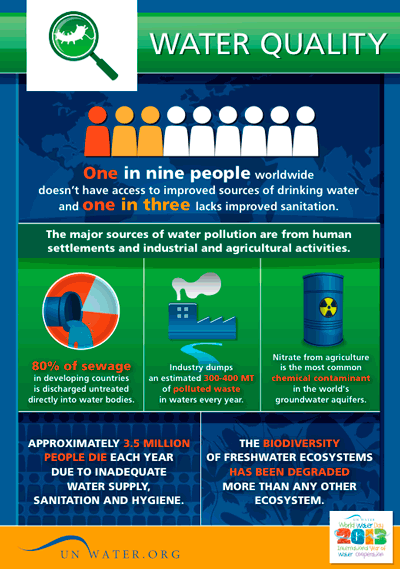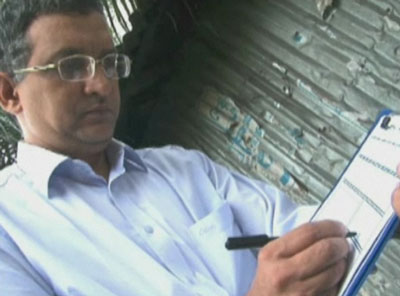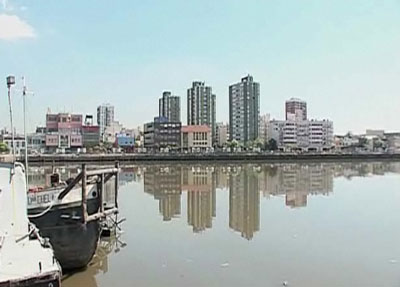- ON THE DECADE
- THE DECADE'S CAMPAIGN
- REPORTING ON PROGRESS
- THE DECADE'S PROGRAMMES
- FOCUS AREAS
-
- Access to sanitation
- Financing water
- Gender and water
- Human right to water
- Integrated Water Resources Management
- Transboundary waters
- Water and cities
- Water and energy
- Water and food security
- Water and sustainable development
- Water and the green economy
- Water cooperation
- Water quality
- Water scarcity
- FOCUS REGIONS
- RESOURCES FOR
- UN e-RESOURCES
Water quality
Without human influences water quality would be determined by the weathering of bedrock minerals, by the atmospheric processes of evapotranspiration and the deposition of dust and salt by wind, by the natural leaching of organic matter and nutrients from soil, by hydrological factors that lead to runoff, and by biological processes within the aquatic environment that can alter the physical and chemical composition of water.
Typically, water quality is determined by comparing the physical and chemical characteristics of a water sample with water quality guidelines or standards. Drinking water quality guidelines and standards are designed to enable the provision of clean and safe water for human consumption, thereby protecting human health. These are usually based on scientifically assessed acceptable levels of toxicity to either humans or aquatic organisms.
Declining water quality has become a global issue of concern as human populations grow, industrial and agricultural activities expand, and climate change threatens to cause major alterations to the hydrological cycle.
Globally, the most prevalent water quality problem is eutrophication, a result of high-nutrient loads (mainly phosphorus and nitrogen), which substantially impairs beneficial uses of water. Major nutrient sources include agricultural runoff, domestic sewage (also a source of microbial pollution), industrial effluents and atmospheric inputs from fossil fuel burning and bush fires. Lakes and reservoirs are particularly susceptible to the negative impacts of eutrophication because of their complex dynamics, relatively longer water residence times and their role as an integrating sink for pollutants from their drainage basins. Nitrogen concentrations exceeding 5 milligrams per litre of water often indicate pollution from human and animal waste or fertilizer runoff from agricultural areas.
An emerging water quality concern is the impact of personal care products and pharmaceuticals, such as birth control pills, painkillers and antibiotics, on aquatic ecosystems. Little is known about their long-term human or ecosystem impacts, although some are believed to mimic natural hormones in humans and other species.
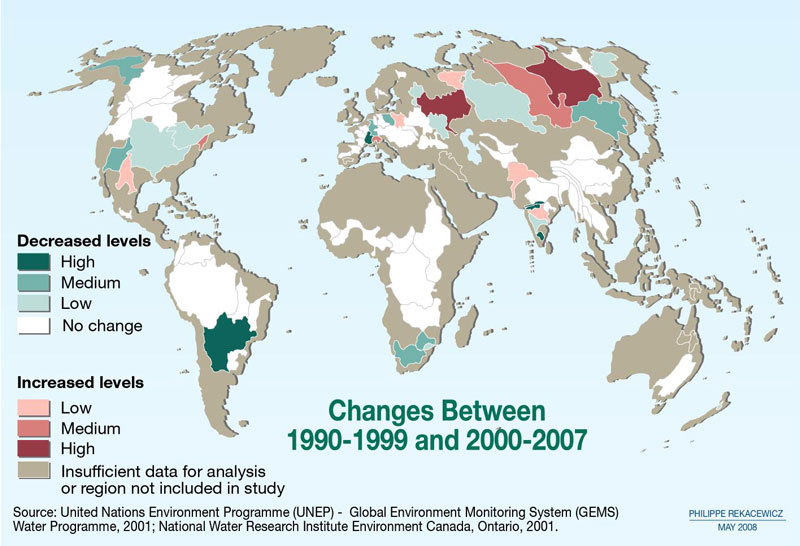
Click on map to enlarge
Nitrate levels: concentrations at river mouths
Source: Vital Water Graphics. UNEP
Poor water quality has a direct impact on water quantity in a number of ways. Polluted water that cannot be used for drinking, bathing, industry or agriculture effectively reduces the amount of useable water within a given area.
Sources:
- Policy Brief on Water Quality. UN-Water, March 2011
- Water Quality for Ecosystems and Human Health. 2nd edition. UNEP, ERCE, UNESCO. 2008
- World Water Development Report 3 'Water in a Changing World'. WWAP, 2009
- Vital Water Graphics. UNEP
Water quality and the MDGs
Water quality management contributes both directly and indirectly to achieving the targets set out in all eight Millennium Development Goals (MDGs), although it is most closely tied to specific targets of the goal 7, to ensure environmental sustainability. Indicators on water quality can be used to demonstrate progress toward the targets, by plotting trends in water quality over time and over space.
Source: Water Quality for Ecosystems and Human Health. 2nd edition. UNEP, ERCE, UNESCO 2008
What is "pollution"?
Pollution typically refers to chemicals or other substances in concentrations greater than would occur under natural conditions. Major water pollutants include microbes, nutrients, heavy metals, organic chemicals, oil and sediments; heat, which raises the temperature of the receiving water, can also be a pollutant. Pollutants are typically the cause of major water quality degradation around the world.
Source: World Water Development Report 3 'Water in a Changing World'
Did you know?
- Every day, 2 million tons of sewage and other effluents drain into the world's waters.
- Every year, more people die from unsafe water than from all forms of violence, including war
- The most significant sources of water pollution are lack of inadequate treatment of human wastes and inadequately managed and treated industrial and agricultural wastes
- The quality of water necessary for each human use varies, as do the criteria used to assess water quality. For example, the highest standards of purity are required for drinking water, whereas it is acceptable for water used in some industrial processes to be of less quality.
UN initiatives that are helping to raise the issue...
- 2010: World Water Day "Clean Water for a Healthy World"
World Water Day is held annually on 22 March as a means of focusing attention on the importance of freshwater and advocating for the sustainable management of freshwater resources. Each year, World Water Day highlights a specific aspect of freshwater. In 2010 World Water Day was dedicated to the theme of water quality. - UN-Water Thematic Priority Area on Water Quality
UN-Water Thematic Priority Area on Water Quality was established in September 2010 to enhance interagency collaboration and coordination on water quality and support Governments and other stakeholders to address water quality challenges. - UN-Water Taskforce on wastewater management
Created in 2009, the UN-Water Taskforce on wastewater management was established to highlight issues surrounding wastewater management, increase awareness by governments, and strengthen UN-System collaboration on activities related to wastewater management.
To know more
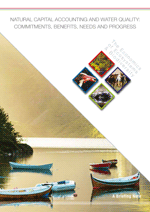 Natural Capital Accounting and Water Quality: Commitments, Benefits, Needs and Progress
Natural Capital Accounting and Water Quality: Commitments, Benefits, Needs and Progress
The Economics of Ecosystems and Biodiversity (TEEB). December 2013
This briefing note outlines existing guidance and examples on water quality accounting. Inspired by the growing global focus on natural capital accounting, it identifies the ongoing challenges related to the development of natural capital accounting and water quality accounting in order to encourage debate and commitment towards effective water and biodiversity policy.
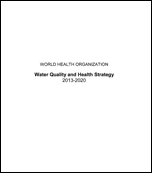 Water Quality and Health Strategy 2013-2020
Water Quality and Health Strategy 2013-2020
World Health Organization (WHO). January 2013
This document sets out the strategy adopted by the World Health Organization (WHO) for the period 2013-2020 to manage water quality with a view to protecting and promoting human health. The strategy is centred on primary prevention of waterborne and water-related diseases. The document provides background information on the burden of disease, linkages with global change, the economic risk-benefit approach; the WHO policy framework, international agreements and strategies; and guidelines for promoting effective policies and practices.
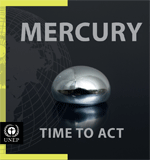 Mercury. Time to Act
Mercury. Time to Act
United Nations Environment Programme (UNEP). January 2013
This report speaks directly to governments involved in development of the global treaty on mercury. It presents updates from the UNEP Global Mercury Assessment 2013 in facts and figures backed by graphics that provide governments and civil society with the rationale and the imperative to act on this notorious pollutant.
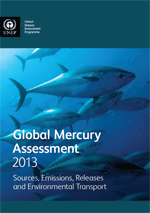 Global Mercury Assessment 2013. Sources, Emissions, Releases and Environmental Transport
Global Mercury Assessment 2013. Sources, Emissions, Releases and Environmental Transport
United Nations Environment Programme (UNEP). January 2013
This report provides the most recent information available on worldwide atmospheric mercury emissions, releases to the aquatic environment, and the transport and fate of mercury in the global environment. The report emphasizes emissions to air from human (anthropogenic) activities, but includes releases to water because the aquatic environment is the main route of exposure to humans and wildlife. It is in aquatic systems that the inorganic mercury is transformed into the more toxic form, methylmercury, which can accumulate in fish and marine mammals consumed by humans.
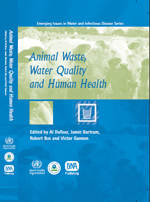 Animal waste, water quality and human health
Animal waste, water quality and human health
World Health Organisation (WHO). October 2012
This book collects relevant information, in connection with five different pathogens, on the scope of domestic animal and bird faeces discharged into the environment, the fate and transport of the faecal wastes (and the pathogens they may contain) that have been discharged into the environment, human exposure to the faecal wastes, potential health effects associated with those exposures and interventions that will limit human exposures to livestock waste. It also addresses the monitoring, detection and management related to these phenomena.
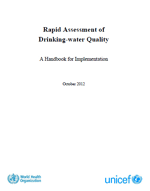 Rapid assessment of drinking-water quality. A handbook for implementation
Rapid assessment of drinking-water quality. A handbook for implementation
United Nations Children's Fund (UNICEF), World Health Organization (WHO). October 2012
This assessment explores the quality of drinking-water from "improved" sources and was conceived to probe into the question to what extent the quality of drinking-water from “improved” sources deviates from the assumption that it is safe. Results in five pilot countries shows a wide range of conditions, from full compliance with the WHO Drinking-water Quality Guidelines to specific sources in a given country only meeting standards in 34% of the samples. The handbook describes the methods and procedures applied by WHO and UNICEF in the five countries, for adoption by any authority or institution that wants to prepare a snapshot of the quality of "improved" sources of drinking-water, as a first step towards strengthening drinking-water quality regulations.
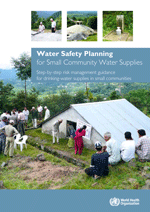 Water Safety Planning for Small Community Water Supplies. Step-by-step risk management guidance for drinking-water supplies in small communities
Water Safety Planning for Small Community Water Supplies. Step-by-step risk management guidance for drinking-water supplies in small communities
World Health Organization (WHO). July 2012
This manual is designed to engage, empower and guide communities in the development and implementation of water safety plans (WSPs) for their drinking-water systems. It provides guidance on how to apply effective and achievable management actions in order to improve the safety and quality of supplied water. Relevant to all community-managed systems, it is applicable to piped schemes, point sources such as hand pumps, protected springs or household rainwater harvesting systems and other sources. The guidance provided is valid for both new and existing schemes.
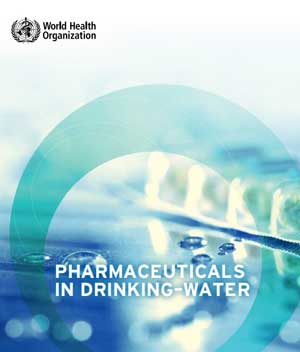 Pharmaceuticals in drinking water
Pharmaceuticals in drinking water
World Health Organization (WHO). June 2012
This technical report aims to provide practical guidance and recommendations in
managing concerns over pharmaceuticals in drinking-water, taking into consideration the
available scientific knowledge and evidence. It emphasizes the importance to prioritize this
emerging issue in the overall context of water safety management, which includes microbial
and other chemical risks that may threaten the safety of drinking-water.
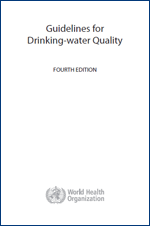 Guidelines for drinking-water quality. 4th edition
Guidelines for drinking-water quality. 4th edition
World Health Organization (WHO). July 2011
This 4th edition of the World Health Organization's Guidelines for Drinking-water Quality builds on over 50 years of guidance by WHO on drinking-water quality, which has formed an authoritative basis for the setting of national regulations and standards for water safety in support of public health. The Guidelines are addressed primarily to water and health regulators, policymakers and their advisors, to assist in the development of national standards. This edition of the Guidelines further develops concepts, approaches and information introduced in previous editions. It considers: drinking-water safety, including minimum procedures and specific guideline values and how these are intended to be used; approaches used in deriving the Guidelines, including guideline values; microbial hazards, which continue to be the primary concern in both developing and developed countries; climate change, which results in changing water temperature and rainfall patterns, severe and prolonged drought or increased flooding, and its implications for water quality and water scarcity, recognizing the importance of managing these impacts as part of water management strategies; chemical contaminants in drinking-water, including information on chemicals not considered previously, such as pesticides used for vector control in drinking water; revisions of existing chemical fact sheets, taking account of new scientific information; those key chemicals responsible for large-scale health effects through drinking water exposure, including arsenic, fluoride, lead, nitrate, selenium and uranium, providing guidance on identifying local priorities and on management; the important roles of many different stakeholders in ensuring drinking-water safety; guidance in situations other than traditional community supplies or managed utilities, such as rainwater harvesting and other non-piped supplies or dual piped systems.
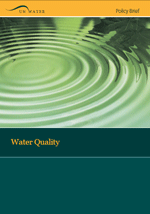 Policy brief on water quality
Policy brief on water quality
UN-Water. March 2011
This policy brief is a collaborative output of UN-Water members and partners directed at practitioners, policymakers and decision-makers in water resource management and other relevant sectors. The policy brief outlines the challenges and trends, drivers and impacts related to water quality. It also presents four strategies that form the basis of policy solutions. It concludes by detailing a series of specific recommendations by which these solutions can be achieved.
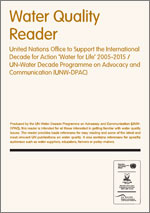 Reader on Water Quality [
Reader on Water Quality [ - 244 KB]
- 244 KB]
UN-Water Decade Programme on Advocacy and Communication (UNW-DPAC). 2010
This reader is intended for all those interested in getting familiar with water quality issues. The reader provides basic references for easy reading and some of the latest and most relevant UN publications on water quality. It also contains references for specific audiences such as water suppliers, educators, farmers or policy-makers.
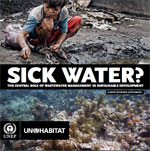 Sick Water. The central role of wastewater management in sustainable development. A rapid response assessment
Sick Water. The central role of wastewater management in sustainable development. A rapid response assessment
[ - 5.93 MB]
- 5.93 MB]
United Nations Environment Programme (UNEP), United Nations Human Settlements Programme (UN-Habitat). 2010
This report identifies the main threats to human and ecological health and the consequences of poor wastewater management and degrading sewage systems. It also presents opportunities, where appropriate policy and management responses over the short and longer term can trigger employment, support livelihoods, boost public and ecosystem health and contribute to more intelligent water management.
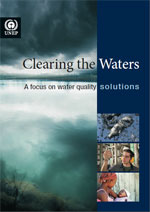 Clearing the Waters: A focus on Water Quality Solutions
Clearing the Waters: A focus on Water Quality Solutions
[ - 5.24 MB]
- 5.24 MB]
United Nations Environment Programme (UNEP). 2010
This publication addresses the urgency of controlling pollution and preserving water quality around the world. Water quality impacts human health, water quantity, livelihood, economic activity, and climate change. Emerging contaminants, population growth and urbanization present additional stresses to water quality. This publication quantifies these water-quality related issues and uses case studies to illustrate both problems and solutions.
WHO Guidelines for drinking-water quality
World Health Organization (WHO)
The World Health Organization produces international norms on water quality and human health in the form of guidelines that are used as the basis for regulation and standard setting, in developing and developed countries worldwide.
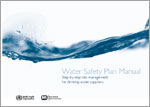 Water Safety Plan Manual: Step-by-step risk management for drinking-water suppliers
Water Safety Plan Manual: Step-by-step risk management for drinking-water suppliers
World Health Organization (WHO). 2009
In 2004, the WHO Guidelines for Drinking Water Quality recommended that water suppliers develop and implement "Water Safety Plans" (WSPs) in order to systematically assess and manage risks. Since this time, governments and regulators, water suppliers and practitioners have increasingly embraced this approach, but they have also requested further guidance. This workbook answers this call by describing how to develop and implement a WSP in clear and practical terms. Stepwise advice is provided through 11 learning modules, each representing a key step in the WSP development and implementation process.
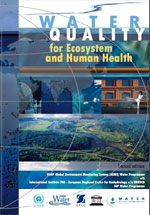 Water Quality for Ecosystems and Human Health. 2nd edition
Water Quality for Ecosystems and Human Health. 2nd edition
[ - 3.12 MB]
- 3.12 MB]
United Nations Environment Programme (UNEP), ERCE, United Nations Educational, Scientific and Cultural Organization (UNESCO). 2008
Drawing on examples from around the world, this publication presents assessments of current water quality status and trends. It also provides an introduction to a diverse range of global water quality issues, including approaches to their identification, analysis and resolution.
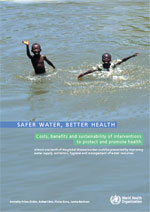 Safer Water, Better Health- Costs, benefits and sustainability of interventions to protect and promote health [
Safer Water, Better Health- Costs, benefits and sustainability of interventions to protect and promote health [ - 2.62 MB]
- 2.62 MB]
World Health Organization (WHO). 2008
This document summarizes the evidence and information related to water and health in a broad sense- encompassing drinking-water supply, sanitation, hygiene, and the development and management of water resources. The report collects the ingredients that support policy decisions, namely the disease burden at stake, the effectiveness of interventions, their costs and impacts, and implications for financing. It presents an overview of current knowledge on the health impacts by country and by disease, and of what has worked to reduce that burden.
UNICEF Handbook on Water Quality [ - 1 MB]
- 1 MB]
United Nations Children's Fund (UNICEF). 2008
This handbook provides an introduction to all aspects of water quality, with a particular focus on the areas most relevant to professionals working in developing countries. It covers the effects of poor water quality, quality monitoring, the protection of water supplies, methods for improving water quality, and building awareness and capacity related to water quality. Finally, the handbook provides an extensive set of links to key water quality references and resources.
Water Quality Interventions to Prevent Diarrhoea: Cost and Cost-Effectiveness
[ - 406 KB]
- 406 KB]
World Health Organization (WHO). 2008
This document makes a review of the effectiveness of water quality interventions to prevent diarrhoea. The analysis is based on cost information from 28 country programmes and computes the cost-effectiveness of conventional improvements of water quality at the source (well, borehole, communal stand post) and four interventions to improve water quality at the household level (chlorination, filtration, solar disinfection and combined flocculation/disinfection). It then employs the generalized cost-effectiveness analysis (CEA) methodology developed by the WHO under its CHOICE project in order to assess the cost-effectiveness of these interventions in 10 WHO epidemiological sub-regions with lower levels of improved water and sanitation coverage.
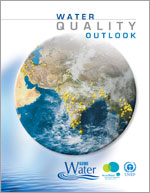 Water Quality Outlook [
Water Quality Outlook [ - 1.40 MB]
- 1.40 MB]
United Nations Environment Programme (UNEP), GEMS/Water, UN World Water Assessment Programme (WWAP). 2007
This report presents a snapshot of global water quality issues as they relate to achieving the internationally agreed goals on water, sanitation and biodiversity. Evidence suggests that there have been improvements in the quality of water in some parts of the world. However, there are serious problems that must be addressed for health and prosperity to be reached universally.
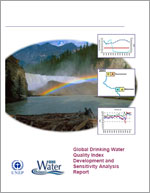 Global Drinking Water Quality Index Development and Sensitivity Analysis Report [
Global Drinking Water Quality Index Development and Sensitivity Analysis Report [ - 2.46 MB]
- 2.46 MB]
United Nations Environment Programme (UNEP), GEMS/Water. 2007
This document outlines an approach taken to develop a global water quality index, as well as preliminary sensitivity analysis and validation of the index against real water quality data. Limitations to the index are discussed, as well as next steps.
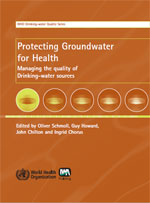 Protecting Groundwater for Health. Managing the quality of drinking-water sources
Protecting Groundwater for Health. Managing the quality of drinking-water sources
World Health Organization (WHO). 2006
This publication provides a structured approach to analysing hazards to groundwater quality, assessing the risk they may cause for a specific supply, setting priorities in addressing these, and developing management strategies for their control. For health professionals, it thus is a tool for access to environmental information needed for such a process, and for professionals from other sectors it gives a point of entry for understanding health aspects of groundwater management.
Water safety plans: Managing drinking-water quality from catchment to consumer
[ - 1.22 MB]
- 1.22 MB]
World Health Organization (WHO). 2005
This document describes the water safety plan approach and further substantiation is provided in a set of companion volumes addressing source protection, treatment processes (at supply and household level), distribution of drinking-water and selection of parameters and analytical methods. It is aimed at practitioners at all levels. It is especially relevant to water quality managers, regulators (including those people responsible for putting together guidance notes on interpretation), auditors, consultants and international organizations.
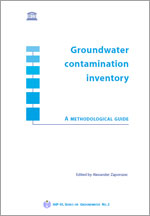 Groundwater Contamination Inventory. A Methodological Guide [
Groundwater Contamination Inventory. A Methodological Guide [ - 7.66 MB]
- 7.66 MB]
United Nations Educational, Scientific and Cultural Organization (UNESCO). 2002
The broad objective of this document is to present a methodology for the inventory of groundwater contamination and to provide a guideline for planning, conducting, evaluating, and presenting the inventory. The guideline is aimed at professionals - as a manual or reference material for hydrogeologists or other specialists responsible for organizing and conducting groundwater contamination inventories, particularly in developing countries.
Water quality - Guidelines, standards and health: Assessment of risk and risk management for water-related infectious disease
World Health Organization (WHO). 2001
To date, the various WHO guidelines relating to water have been developed in isolation from one another. The potential to increase consistency in approaches to assessment and management of water related microbial hazards was discussed by an international group of experts between 1999 and 2001. These discussions led to the development of a harmonised framework, which was intended to inform the process of development of guidelines and standards. Subsequently, a series of reviews was progressively developed and refined, which addressed the principal issues of concern linking water and health to the establishment and implementation of effective, affordable and efficient guidelines and standards. This book is based on these reviews, together with the discussions of the harmonised framework and the issues surrounding it.
Water pollution control [ - 3.99 MB]
- 3.99 MB]
United Nations Environment Programme (UNEP), World Health Organization (WHO), Water Supply and Sanitation Collaborative Council (WSSCC). 1997
This handbook addresses specific aspects of water resources management and water pollution control. A series of case studies from various regions is also included, highlighting successful models of wastewater management and pollution control from different parts of the world. This is a handbook for policy makers and environmental managers in water authorities and engineering companies engaged in water quality programmes, especially in developing countries. It is also suitable for use as a textbook or as training material for water quality management course.
Water quality around the world
Africa
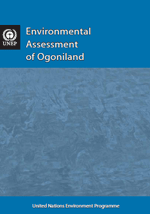 Environmental Assessment of Ogoniland
Environmental Assessment of Ogoniland
Executive summary
United Nations Environment Programme (UNEP). August 2011
Ogoniland has been the site of oil industry operations since the late 1950s. Ogoniland has a tragic history of pollution from oil spills and oil well fires, although no systematic scientific information has been available about the ensuing contamination. The Environmental Assessment of Ogoniland covers contaminated land, groundwater, surface water, sediment, vegetation, air pollution, public health, industry practices and institutional issues. This report represents the best available understanding of what has happened to the environment of Ogoniland – and the corresponding implications for affected populations – and provides clear operational guidance as to how that legacy can be addressed.
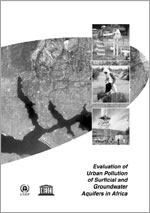 Evaluation of Urban Pollution of Surficial and Groundwater Aquifers in Africa [
Evaluation of Urban Pollution of Surficial and Groundwater Aquifers in Africa [ - 314 KB]
- 314 KB]
United Nations Environment Programme (UNEP), United Nations Educational, Scientific and Cultural Organization United Nations Educational, Scientific and Cultural Organization (UNESCO). 2002
The Urban Pollution of Surficial and Groundwater Aquifers in Africa is a joint UNEP and UNESCO project that addresses the issue of aquifer vulnerability and the need to protect the quality of the continent's groundwater resources. This report presents the findings of this project evaluation.
Asia
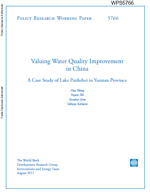 Valuing Water Quality Improvement in China. A Case Study of Lake Puzhehei in Yunnan Province
Valuing Water Quality Improvement in China. A Case Study of Lake Puzhehei in Yunnan Province
World Bank. August 2011
This paper reports an economic valuation study conducted in Yunnan, China, which aims to estimate the total value of a real investment project to improve the water quality of Lake Puzhehei. Located in Qiubei County, which is far from large cities, the lake has been experiencing fast water quality deterioration in the past years. This study also demonstrates that previous knowledge about water quality changes and the project may have a significant positive impact on people's valuation.
Europe
Recommendations to ECE Governments on water quality criteria and objectives
[ - 86.8 KB]
- 86.8 KB]
United Nations Economic Commission for Europe (UNECE). 1993
This document provides further guidance in the elaboration of water-quality criteria and the formulation and setting-up of water-quality objectives for inland surface waters with a view to strengthening international cooperation.
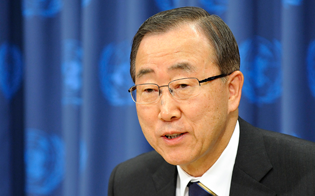
"Our indispensable water resources have proven themselves to be greatly resilient, but they are increasingly vulnerable and threatened. Our growing population's need for water for food, raw materials and energy is increasingly competing with nature's own demands for water to sustain already imperilled ecosystems and the services on which we depend. Day after day, we pour millions of tons of untreated sewage and industrial and agricultural wastes into the world's water systems. Clean water has become scarce and will become even scarcer with the onset of climate change. And the poor continue to suffer first and most from pollution, water shortages and the lack of adequate sanitation."
Ban Ki-moon, UN Secretary General
>> Bangladesh: Traces of Poison in Water
UN in Action
Place: Bangladesh
Year: 2011
Duration: 6min48sec
In 1993, Bangladesh found its main source of fresh water tainted with naturally occurring arsenic posing a public health risk to millions. Since then, the country has partnered with the World Bank and the International Atomic Energy Agency (IAEA) to introduce isotope hydrology techniques to locate safe sources of water.
>> Argentina: Dreaming of a Clean River
UNTV 21st Century
Place: Argentina
Year: 2011
Duration: 6min27sec
One of the world's most polluted rivers flows through Argentina's capital Buenos Aires and threatens the health of the city's poorest people. Now, one determined nine-year-old girl and her tenacious mother have decided enough is enough.
>> Kosovo: Water
UNICEF, UNTV: UN in Action
Place: Kosovo
Year: 2009
Duration: 2min29sec
In Central Kosovo, water sources dry up early in the summer. Consumption of impure water leads to many diseases in the rural areas. A project from UNICEF is educating local children on basic hygiene and the importance of clean water.
Copyright | Terms of use | Privacy notice | Site Index | Fraud alert | Help





